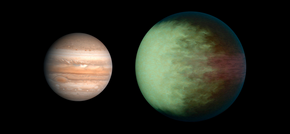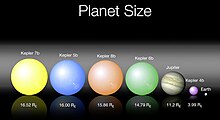Kepler-7b
 Size comparison of Kepler-7b with Jupiter, showing a rudimentary map of its atmosphere[1]derived from telescope observations. | |
| Discovery[2] | |
|---|---|
| Discovery date | January 4, 2010[3] |
| Transit(Kepler Mission)[2] | |
| Orbital characteristics | |
| 0.06224AU | |
| Eccentricity | 0[2] |
| 4.885525±0.000040[2]d | |
| Inclination | 86.5[4] |
| Star | Kepler-7 |
| Physical characteristics | |
| 1.478+0.050 −0.051[2]RJ | |
| Mass | 0.433+0.040 −0.041[2]MJ |
Meandensity | 0.166+0.019 −0.020g/cm3[citation needed] |
| Albedo | 0.32±0.03[5][6] |
| Temperature | 1,540 K (1,270 °C; 2,310 °F)[2] |
Kepler-7bis one of the first fiveexoplanetsto be confirmed byNASA'sKeplerspacecraft, and was confirmed in the first 33.5 days of Kepler's science operations.[2]It orbits a star slightly hotter and significantly larger than the Sun that is expected to soon reach the end of themain sequence.[2]Kepler-7b is ahot Jupiterthat is about half the mass of Jupiter, but is nearly 1.5 times its size; at the time of its discovery, Kepler-7b was the second most diffuse planet known, surpassed only byWASP-17b.[2]It orbits its host star every five days at a distance of approximately 0,06 AU (9.000.000 km or 5.592.340 mi). Kepler-7b was announced at a meeting of theAmerican Astronomical Societyon January 4, 2010. It is the first extrasolar planet to have a crude map of cloud coverage.[7][8][9]
Characteristics
[edit]Mass, temperature, and orbit
[edit]Kepler-7b is ahot Jupiter,a Jupiter-like exoplanet orbiting close to its star. Itsequilibrium temperature,due to its proximity to its star, is hot and is measured at nearly 1540K.However, of the first five planets discovered by Kepler, it is the second coolest, being surpassed only byKepler-6b.[4]This is over twelve times hotter than Jupiter.[4]Kepler-7b has a mass of only 0.433 that ofJupiterbut due to proximity to its star the planet has expanded to a radius of 1.478 that ofJupiter.Because of this its mean density is only 0.166 g/cm3,about the same asexpanded polystyrene.OnlyWASP-17b(0.49MJ;1.66RJ)[10]was known to have a lower density at the time of Kepler-7b's discovery.[2]Such low densities are not predicted by current standard theories of planet formation.[11]
Kepler-7b orbits its host star every 4.8855 days at a distance of0.06224AU,making it the furthest-orbiting planet of the first five discovered by Kepler.Mercury,in contrast, orbits at a distance of 0.387 AU every 87.97 days.[12]In addition Kepler-7b has an observedorbital inclinationof 86.5º, which means that its orbit is almost edge-on as seen from Earth.[4]
Cloud mapping
[edit]Astronomers using data from NASA's Kepler and Spitzer space telescopes have created a cloud map of the planet. It is the first cloud map to be created beyond the Solar System. Kepler's visible-light observations of Kepler-7b's Moon-like phases led to a rough map of the planet that showed a bright spot on its western hemisphere.[13]But these data were not enough on their own to decipher whether the bright spot was coming from clouds or heat. The Spitzer Space Telescope played a crucial role in answering this question.[14]Jonathan Fortney,professor of astronomy and astrophysics atUC Santa Cruz,said: "These clouds may well be composed of rock and iron, since the planet is over 1,000 degrees Fahrenheit (500 degrees Celsius)." Brice-Olivier Demory of the Massachusetts Institute of Technology noted that the oceans and continents cannot be detected, but a clear reflective signature has been detected which is interpreted as cloud. Thomas Barclay, Kepler scientist at NASA's Ames Research Center, said: "Unlike those on Earth, the cloud patterns on this planet do not seem to change much over time—it has a remarkably stable climate."[1]
Host star
[edit]Kepler-7is the largest host star of the first five planets detected by Kepler, and is situated in theLyraconstellation. The star has aradius184% that of the Sun. Kepler-7 also has 135% the Sun's mass, and thus is larger and more massive (though less dense) than the Sun. It is slightly hotter than the Sun, as Kepler-7 has aneffective temperatureof5933 K.[15]The star is near the end of its life on themain sequence.[2]The star'smetallicityis [Fe/H] = 0.11, which means that Kepler-7 has 128% the amount of iron than is detected in the Sun.[15]
Discovery
[edit]

In 2009,NASA'sKepler space telescopewas completing the last of tests on itsphotometer,the instrument it uses to detecttransitevents, in which a planet crosses in front of and dims its host star for a brief and roughly regular period of time. In this last test, Kepler observed50000stars in theKepler Input Catalog,including Kepler-7; the preliminary light curves were sent to the Kepler science team for analysis, who chose obvious planetary companions from the bunch for follow-up at observatories. Kepler-7 was not one of these original candidates.[2]After a resting period of 1.3 days, Kepler began a nonstop 33.5-day period in which it observed150000targets uninterrupted until June 15, 2009, when the collected data was downloaded and tested forfalse positives.Kepler-7's candidate was not found to be one of these false positives, such as aneclipsing binarystar that may generate a light curve that mimics that of transiting planetary companions.
Kepler-7 was then observed usingDoppler spectroscopyusing theFibre-fed Echelle Spectrographat the Canary Islands'Nordic Optical Telescopefor ten nights in October 2009, taken regards to the star HD 182488 to compensate for possible telescope error.Speckle imagingof the star was taken atWIYN Observatoryin Arizona to check for close companions; when none were found, theHigh Resolution Echelle Spectrometerinstrument at theW.M. Keck Observatoryon Hawaii, theHarlan J. Smith Telescopeat theMcDonald Observatoryin Texas, the PRISM camera at theLowell Observatory,and theFaulkes Telescope Northat theHaleakala Observatoryon Maui were also used to analyze Doppler spectroscopy of the planetary candidate.
The radial velocity observations confirmed that a planetary body was responsible for the dips observed in Kepler-7's light curve, thus confirming it as a planet.[2]Kepler's first discoveries, including the planetsKepler-4b,Kepler-5b,Kepler-6b,Kepler-7b, andKepler-8b,were first announced on January 4, 2010, at the215th meetingof theAmerican Astronomical Societyin Washington, D.C.[3]In May 2011, the planet was detected by brightness variations of the star cause by reflected starlight from the planet. It was found that Kepler-7b has a relatively high geometric albedo of 0.3.[16]
References
[edit]- ^abNASA/JPL (30 September 2013)."Astronomers find patchy clouds on exotic world".NASA.Retrieved1 October2013.
- ^abcdefghijklmnLatham, David W.; et al. (2010)."Kepler-7b: A Transiting Planet with Unusually Low Density".The Astrophysical Journal Letters.713(2): L140–L144.arXiv:1001.0190.Bibcode:2010ApJ...713L.140L.doi:10.1088/2041-8205/713/2/L140.
- ^abRon Cowen (4 January 2010)."Kepler space telescope finds its first extrasolar planets".Science News. Archived fromthe originalon 25 September 2012.Retrieved4 January2010.
- ^abcd "Summary Table of Kepler Discoveries".NASA. 15 March 2010. Archived fromthe originalon 27 May 2010.Retrieved18 March2010.
- ^Angerhausen, Daniel; DeLarme, Em; Morse, Jon A. (2015). "A Comprehensive Study of Kepler Phase Curves and Secondary Eclipses: Temperatures and Albedos of Confirmed Kepler Giant Planets".Publications of the Astronomical Society of the Pacific.127(957): 1113–1130.arXiv:1404.4348.Bibcode:2015PASP..127.1113A.doi:10.1086/683797.S2CID118462488.
- ^Heng, Kevin; Demory, Brice-Oliver (2013). "Understanding Trends Associated With Clouds In Irradiated Exoplanets".The Astrophysical Journal.777(2): 100.arXiv:1309.5956.Bibcode:2013ApJ...777..100H.doi:10.1088/0004-637X/777/2/100.S2CID119298230.
- And errata inHeng, Kevin; Demory, Brice-Olivier (2014)."ERRATUM:" UNDERSTANDING TRENDS ASSOCIATED WITH CLOUDS IN IRRADIATED EXOPLANETS "(2013, ApJ, 777, 100)".The Astrophysical Journal.785:80.doi:10.1088/0004-637X/785/1/80.
- ^Clavin, Whitney; Johnson, Michele; Cole, Steve (30 September 2013)."NASA Space Telescopes Find Patchy Clouds on Exotic World".NASA.Archived fromthe originalon 17 October 2013.Retrieved30 September2013.
- ^Chu, Jennifer (2 October 2013)."Scientists generate first map of clouds on an exoplanet".MIT.Retrieved2 January2014.
- ^Demory, Brice-Olivier; et al. (2013). "Inference of Inhomogeneous Clouds in an Exoplanet Atmosphere".The Astrophysical Journal Letters.776(2): L25.arXiv:1309.7894.Bibcode:2013ApJ...776L..25D.doi:10.1088/2041-8205/776/2/L25.S2CID701011.
- ^"The Planets".SuperWASP.Archived fromthe originalon 7 March 2012.Retrieved8 June2010.
- ^Henderson, Mark (5 January 2010)."Kepler telescope finds five new worlds".London: Timesonline.Retrieved29 May2010.
- ^David Williams (17 November 2010)."Mercury Fact Sheet".Goddard Space Flight Center.NASA.Retrieved10 May2011.
- ^Shporer, Avi; Hu, Renyu (2015), "Studying Atmosphere-Dominated Hot Jupiterkeplerphase Curves: Evidence That Inhomogeneous Atmospheric Reflection is Common",The Astronomical Journal,150(4): 112,arXiv:1504.00498,Bibcode:2015AJ....150..112S,doi:10.1088/0004-6256/150/4/112,S2CID33182939
- ^"NASA Space Telescopes Find Patchy Clouds on Exotic World".NASA.30 September 2013. Archived fromthe originalon 17 October 2013.Retrieved1 October2013.
- ^abJean Schneider (2010)."Notes for star Kepler-6".Extrasolar Planets Encyclopaedia.Archived fromthe originalon 21 January 2011.Retrieved9 May2011.
- ^Demory, Brice-Olivier; et al. (2011). "The High Albedo of the Hot Jupiter Kepler-7B".The Astrophysical Journal Letters.735(1): L12.arXiv:1105.5143.Bibcode:2011ApJ...735L..12D.doi:10.1088/2041-8205/735/1/L12.S2CID399287.
External links
[edit] Media related toKepler-7 bat Wikimedia Commons
Media related toKepler-7 bat Wikimedia Commons

